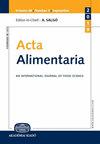顺序乳化和冷冻干燥工艺对特级初榨橄榄油的微胶囊化:壁材组成和乳化方法的影响
IF 1
4区 农林科学
Q4 FOOD SCIENCE & TECHNOLOGY
引用次数: 0
摘要
长期以来,橄榄油一直被认为是生物制药的配方,并因其独特的感官和营养特性而在烹饪中享有盛誉。然而,橄榄油中脂肪酸的氧化提供了短的保质期和不良的感官特性。因此,橄榄油的微胶囊化是保持其质量和生物活性的一种非常有前途的方法。本研究的目的是通过壁材(基质)对橄榄油的水乳化和乳液的冷冻干燥等顺序技术制备特级初榨橄榄油微胶囊。考察了壁材组成对制备特级初榨橄榄油微胶囊的影响。使用不同比例的壁材料,如麦芽糊精(MD)、羧甲基纤维素(CMC)和阿拉伯树胶(GA)。此外,还研究了乳化技术的影响,如转子-定子均化器(RSH)的均化和错流膜乳化(CFME)。RSH法制备的乳液稳定性较好;然而,与CFME相比,在RSH的情况下液滴平均直径(D32)更低。当采用CFME,壁材组成为15时,包封效率最高,为68.96±2.6% g MD,15 g GA和5 g CMC。本文章由计算机程序翻译,如有差异,请以英文原文为准。
Microencapsulation of extra virgin olive oil by sequential emulsification and freeze drying processes: Effect of wall materials composition and emulsification method
For a long time, olive oil has been considered for formulation of biopharmaceuticals and received a prestigious place in cuisine for its unique organoleptic and nutritional properties. Nevertheless, oxidation of fatty acids in olive oil provides short shelf-life and undesirable organoleptic properties. Thus, microencapsulation of olive oil is a considerable promising approach to maintain its quality and biological activities. The objective of this investigation was to prepare extra virgin olive oil microcapsule by sequential technologies, such as water emulsification of olive oil with wall material (matrix) and freeze drying of emulsion. The effect of wall material composition was examined to prepare microcapsule of extra virgin olive oil. Different ratios of wall materials such as maltodextrin (MD), carboxymethyl cellulose (CMC), and gum arabic (GA) were used. Furthermore, effects of emulsification technologies, such as homogenisation with rotor–stator homogeniser (RSH) and cross-flow membrane emulsification (CFME) were investigated. The stability of emulsion was higher when emulsion was prepared by RSH; however, the droplet mean diameter (D32) was lower in case of RSH compared to CFME. The highest encapsulation efficiency (EE) was found as 68.96 ± 2.6% when CFME was adopted and composition of wall materials was 15 g MD, 15 g GA, and 5 g CMC.
求助全文
通过发布文献求助,成功后即可免费获取论文全文。
去求助
来源期刊

Acta Alimentaria
农林科学-食品科技
CiteScore
1.80
自引率
0.00%
发文量
47
审稿时长
18-36 weeks
期刊介绍:
Acta Alimentaria publishes original papers and reviews on food science (physics, physical chemistry, chemistry, analysis, biology, microbiology, enzymology, engineering, instrumentation, automation and economics of foods, food production and food technology, food quality, post-harvest treatments, food safety and nutrition).
 求助内容:
求助内容: 应助结果提醒方式:
应助结果提醒方式:


